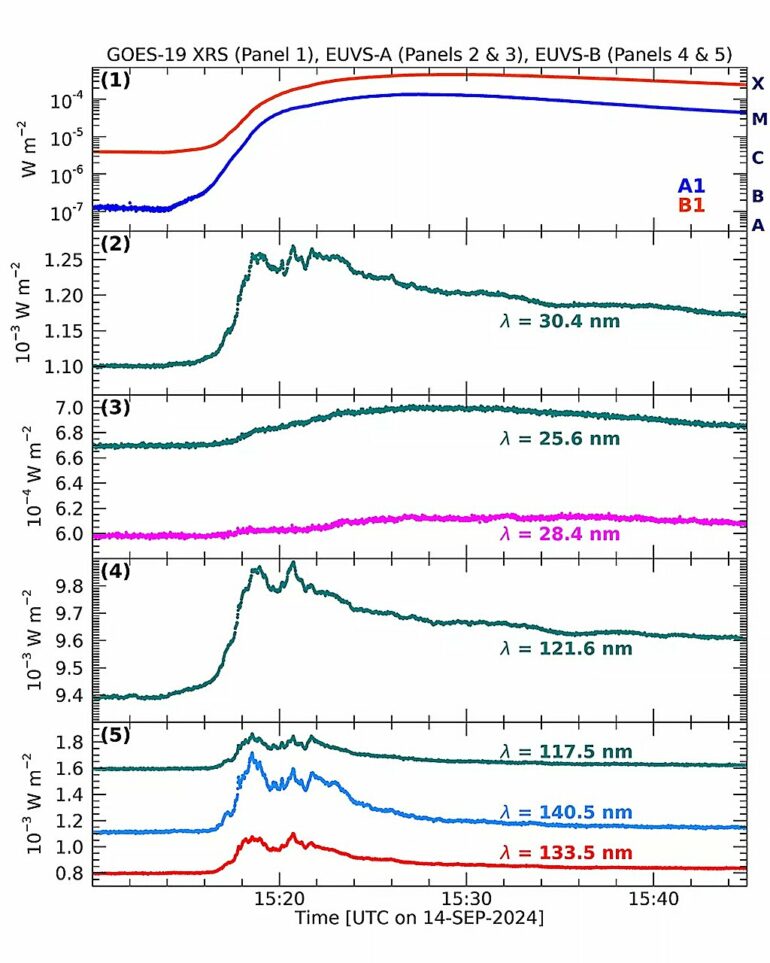The Extreme Ultraviolet and X-ray Irradiance Sensors (EXIS) onboard NOAA’s GOES-19 satellite, which launched on June 25, 2024, are powered on, performing well, and observing the sun.
EXIS measures light from the sun in extreme ultraviolet and soft X-ray (lower energy) wavelengths and identifies the magnitude and location of solar flares. Solar flares are huge eruptions of energy on the sun and often produce clouds of plasma traveling more than a million miles per hour.
When these plasma clouds reach Earth, they can cause radio communications blackouts, disruptions to electric power grids, errors in GPS navigation, and hazards to satellites and astronauts. Additionally, variations in the solar X-ray and ultraviolet light that is absorbed by Earth’s upper atmosphere can impact radio communications and satellite drag.
The sun has periodic increases in the complexity of its magnetic field on a roughly 11-year basis, usually referred to as the “solar cycle.” This complexity not only increases the brightness of the sun in the extreme ultraviolet and soft X-rays, but it also results in increased frequency and magnitude of solar flares. The sun is currently at or near the peak of the current solar cycle, also called solar maximum.
EXIS has two main sensors, the X-Ray Sensor (XRS), which measures soft X-rays, and the Extreme Ultraviolet Sensors (EUVS), which measure extreme ultraviolet light. On September 14, 2024, within a day of the GOES-19 EXIS opening its door and looking at the sun, an X-class solar flare occurred.
The X stands for “extreme,” the most energetic class of flares, seen in the XRS data in Panel (1) above in units of irradiance [W m-2]. This particular flare erupted from an active region (AR13825) of the sun that had just rotated into Earth’s view. It was accompanied by a large ejection of plasma, which takes about two to three days to get to Earth. EXIS provides the first notice of a flare occurring on the sun. This flare resulted in aurorae visible as far south as Texas.
EXIS, with its multiple sensors, can observe and quantify the light from solar flares and help determine in real-time whether the flares will affect us on Earth. By looking at many wavelengths, scientists can also observe details of the physics of the flares themselves.
For instance, the September 14 flare didn’t just rise to a sharp peak then decay away in the soft X-rays and EUV. Instead, the brightness at these wavelengths pulsated, peaking multiple times within several minutes [as seen in Panels (2), (4), and (5) in the image above], indicating that the energetics of the flare are complex.
The EXIS data capturing these pulsations help researchers learn more about solar dynamics. The results are published in The Astrophysical Journal Letters.
GOES-19 is currently undergoing post-launch testing and checkout of its instruments and systems. After GOES-19 is assigned the operational role as NOAA’s GOES-East satellite in April 2025, EXIS data will provide NOAA’s Space Weather Prediction Center with early indications of impending space weather storms so forecasters can issue alerts, watches, and warnings.
More information:
Thomas D. Eden et al, Solar Atmospheric Oscillations as Measured by the GOES-R Series EXIS EUVS-C Instrument, The Astrophysical Journal Letters (2024). DOI: 10.3847/2041-8213/ad73d9
Citation:
NOAA shares first data from GOES-19 EXIS instrument (2024, September 26)



